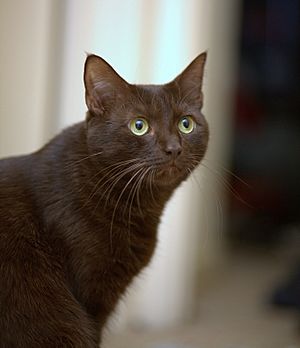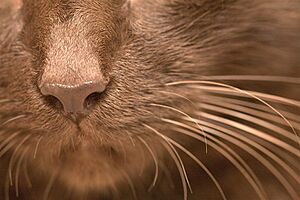Havana Brown facts for kids
Quick facts for kids Havana Brown |
|
|---|---|
 |
|
| Other names | Havana |
| Common nicknames | HB |
| Origin | England |
| Breed standards | |
| CFA | standard |
| TICA | standard |
| AACE | standard |
| ACFA/CAA | standard |
| CCA-AFC | standard |
| Notes | |
|
A phenotypically similar cat is recognized by the GCCF as the Suffolk Chocolate. The Suffolk is NOT the same as the Havana Brown. The standard for the breed is different and the cats used for outcross to develop the recently created breed is different than those found in the Havana Brown. The registers CFA, TICA, ACFA and LOOF all use the same breed standard for showing and breeding the Havana/Havana Brown Cat. The Suffolk Chocolate is not allowed in the breeding lines of the Havana Brown in any of these registers.
|
|
| Domestic cat (Felis catus) | |
The Havana Brown is a special type of cat. It was created in England in the 1950s. A group of cat lovers carefully bred Siamese cats with black domestic cats to get this unique brown color.
Did you know that brown cats were seen in Europe way back in the 1890s? They were sometimes called Swiss Mountain Cats. But these cats disappeared for a while after World War II. The modern Havana Brown breed started fresh in the 1950s. Even though they look similar, the Swiss Mountain Cat was not used to create today's Havana Brown. However, they probably share some genes because of their Siamese ancestors.
Contents
What Makes a Havana Brown Cat Special?
Physical Features of Havana Brown Cats
The Havana Brown is a medium-sized cat with strong muscles and short fur. They have a balanced body that is not too long or too short. Their fur must be a warm brown color, often with a reddish tint. You won't see tabby stripes on adult Havana Browns, but kittens might have them. These stripes usually disappear by the time the cat is one year old.
Their whiskers are brown, and their eyes are a beautiful green color. Their paw pads are pink or rose-colored. The Havana Brown has a head that is a bit longer than it is wide. When you look at their face from the side, their nose has a clear dip. Male Havana Browns are usually bigger than females. Overall, they are attractive cats with no extreme features.
Havana Brown Cat Behavior and Personality
Havana Browns are very smart cats. They often use their paws to explore things and even to talk to their owners! They are curious and will often greet visitors at the door instead of hiding. It's common for a Havana Brown to gently tap your leg and meow to say hello.
These cats are playful and love to explore. They are rarely destructive, especially if they have company. Many Havana Browns enjoy sitting on laps, while others prefer to sit quietly next to their human friends. Some even like to ride on your shoulders and "help" with daily tasks! They also have a funny habit of playing in and grooming people's hair. It happens so often that owners might not even notice it until someone points it out.
Havana Browns get very close to their families. They don't like being left alone for long periods. They are curious and enjoy being part of everything you do. It's not unusual for a Havana Brown to become best friends with the family dog. Many owners are also surprised by how easily their Havana Brown cats can travel without getting upset.
Why Are They Called Havana Brown?
The most popular idea for the breed's name is that their rich brown fur looks a lot like Havana cigars. However, some people think the name comes from the Havana (rabbit), which also has a similar brown color. This second idea might be more accurate, based on the history of the breed in England.
Easy Grooming for Havana Brown Cats
Havana Browns don't need much grooming. A gentle brushing and a quick wipe with a damp cloth once or twice a week is usually enough. Giving them good quality food also helps keep their coat healthy.
Havana Brown Cat Health
There are no major genetic diseases known to affect Havana Brown cats. They might have a slightly higher chance of getting gingivitis (gum inflammation) than other breeds. This is thought to be due to their Siamese cat family history.
Havana Brown Cat Recognition
The Havana Brown breed has been recognized for cat shows in the United States since the late 1950s. For a while, it was considered a rare breed because there weren't many of them. In the late 1990s, there were only a few Havana Brown breeders and not many cats.
However, since then, the breed has grown steadily. By 2015, there were twice as many breeders around the world, mostly in the US and Europe. This means more people can enjoy these wonderful brown cats!
See also
 In Spanish: Habana brown para niños
In Spanish: Habana brown para niños


